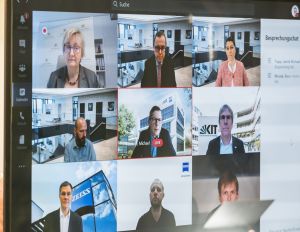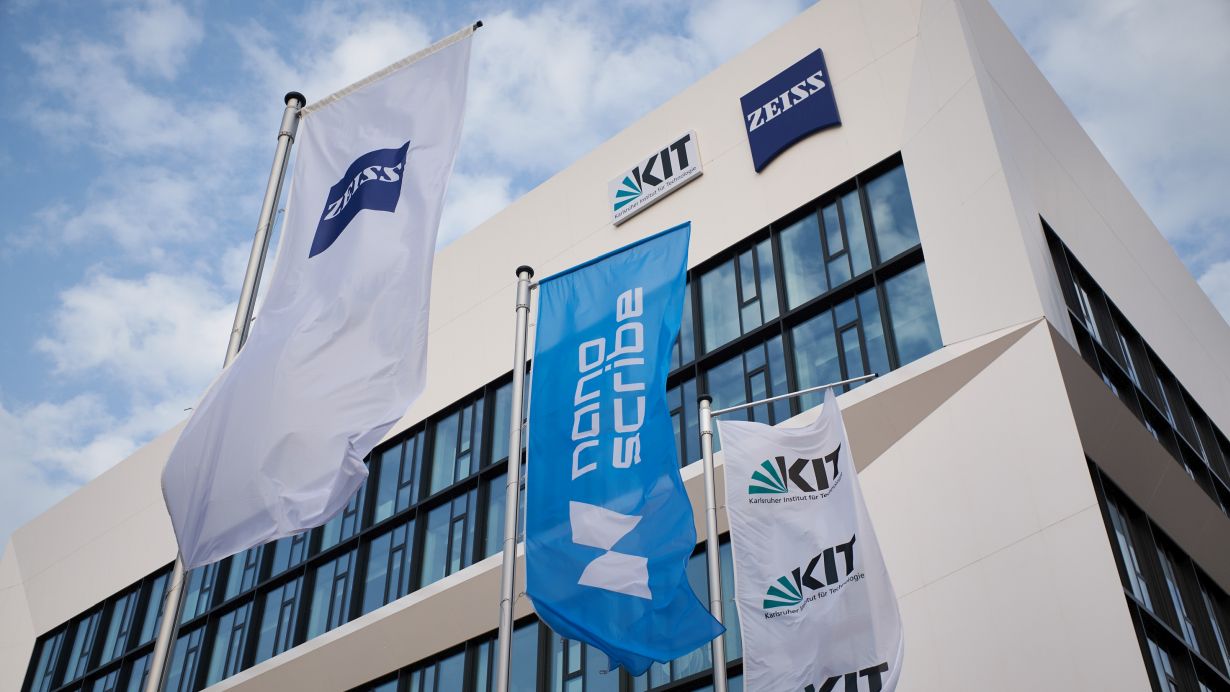The ZEISS Innovation Hub @ KIT is a milestone in the longstanding partnership between ZEISS and the Karlsruhe Institute of Technology (KIT). In the new building on KIT’s North Campus ZEISS enables high-tech and digital startups to move into the Hub, and is driving its own innovation and new business activities. The Hub has seen a number of successful collaborations and projects since it opened in early 2020.
The ZEISS Innovation Hub @ KIT on the North Campus of the Karlsruhe Institute of Technology (KIT) commenced operations back in January 2020, but has not been able to hold an official opening due to the pandemic – until yesterday, that is, when the opening was honored in a virtual ceremony.
The President and CEO of the ZEISS Group, Dr. Karl Lamprecht, was accompanied by collaboration partners KIT and Nanoscribe as he welcomed representatives from politics, business and science. Speeches were given by Baden-Württemberg's Minister of Science Theresia Bauer, KIT President Professor Holger Hanselka and Chairman of the KIT Supervisory Board Professor Michael Kaschke.
In his opening speech, Dr. Lamprecht said: "ZEISS invests over 10 percent – most recently, 13 percent – of its revenue in research and development work. As part of our innovation strategy, the Innovation Hub gives us the chance to shape future technologies in collaboration with our partners. The ZEISS Innovation Hub @ KIT allows us to network in creative, young and high-tech research environments, at one of Germany's most innovative sites with its unique energy and ambience."
In his speech, Professor Michael Kaschke added: "The ZEISS Innovation Hub @ KIT allows the KIT and Carl Zeiss AG to pool their innovative prowess, thus laying excellent foundations for new ideas and innovations, and for their advancement. As Chairman of the Supervisory Board of the KIT and former ZEISS President and CEO, I am delighted with the project and the modern building, which is a beacon for successful public-private partnerships in Germany."
KIT President, Professor Holger Hanselka, agreed: "We can only successfully take new technologies where they are truly needed – to people and companies – by merging the worlds of science and business, research and innovation. And that is exactly what we have spent many years preparing for with our partner ZEISS. The ZEISS Innovation Hub @ KIT has intensified these preparations, and given them new momentum. I am especially delighted that the first startups from the KIT high-tech incubator have found a home here. In many ways, therefore, the Hub is bolstering the innovation activities at the KIT and well beyond both the city and region."
Minister of Science Theresia Bauer emphasized that "The world as we know it is changing. New consumer and communication habits, as well as new working and mobility trends, are calling established solutions and business models into question. These changes offer new opportunities and we want to make the most of them. To do this, we need creative minds that dare to try new things. This requires innovative partnerships between fresh and established companies, as well as closer collaborations between the science and business worlds. And these three things are coming together at the ZEISS Innovation Hub @ KIT. This creates a key and distinctive place in which startups are networked across regions, bringing science and business closer together. In other words, this place is a shining example of Baden-Württemberg as an innovation hub."

honored in a virtual ceremony in January 2021.
(Photo: Markus Breig, KIT)
Looking back over the first successful year of the Innovation Hub
Those using the new facility on the North Campus of the KIT, which is spread over 12,000 square meters, include ZEISS and the KIT, 3D printing and microfabrication company Nanoscribe, as well as current and future startups and carve-outs planned by both partners.
At the ZEISS Innovation Hub @ KIT, the research university in the Helmholtz community also has the chance to rent new spaces for its own carve-outs and innovation activities, offering them long-term prospects at the site.
Nanoscribe founder Martin Hermatschweiler; Thomas Neumann, who is in charge of the KIT high-tech incubator; and Max Riedel, ZEISS team leader at the Innovation Hub, shared their impressions of the facility and looked back over its first year. A lot has happened in this initial phase despite the limitations imposed by the COVID-19 pandemic.
The ZEISS Innovation Hub offers excellent opportunities for Nanoscribe to research and develop new, tailored solutions for microfabrication in research and industry contexts. The new production line for Quantum X, a maskless lithography system with nanometer precision, is currently housed at the Innovation Hub, and the first systems were shipped in 2020. This contributed significantly to the company's revenue growth.
The first four startups (voxalytic, microworks, aquarray and HS-Analysis) have moved into the KIT high-tech incubator and the chem labs are now complete. The ZEISS team has launched a series of collaborations with academic partners in the areas of medical robotics and distance measurement with integrated photonics, and grew from two to 14 employees in its first year. There are already plans to focus on further topics and expand the team.
Collaborations and projects at one of Germany's most innovative sites
ZEISS has long been collaborating with Professor Martin Wegener from the KIT Institute for Applied Physics, whose lab spawned Nanoscribe over ten years ago. Wegener and ZEISS employee Stefan Richter reported on their joint project in a "tandem talk": they demonstrated how nano 3D printing can be used to create safety features, and provided information on the "nano factory of the future."
Professor Franziska Mathis-Ulrich from the KIT and Christoph Hauger from ZEISS Medical Technology gave a second "tandem talk" in which they provided an overview of the latest developments and spoke about the future of medical robotics.
The ZEISS Maker Space@KIT is a collaboration between ZEISS and the excellence cluster 3D Matter Made to Order. As soon as the COVID-19 situation permits it, it will be made available to schoolkids, students and to the employees of ZEISS and KIT so that they can create small prototypes. In the past year, Maker Space has been used in workshops with small groups of schoolkids and students, as well as for ZEISS projects. Jonas Wohlgemuth from the KIT Institute of Functional Interfaces briefly discussed the opportunities afforded by Maker Space, and the first activities it is working on.
Niklas Borchers studied at the KIT and spoke about his experience with ZEISS through several hands-on units, which led to his current position as a postgraduate student, and much more. During this time, he worked on exciting topics like quantum sensors and on measuring tiny installation spaces
Being “The Research University in the Helmholtz Association”, KIT creates and imparts knowledge for the society and the environment. It is the objective to make significant contributions to the global challenges in the fields of energy, mobility, and information. For this, about 10,000 employees cooperate in a broad range of disciplines in natural sciences, engineering sciences, economics, and the humanities and social sciences. KIT prepares its 22,800 students for responsible tasks in society, industry, and science by offering research-based study programs. Innovation efforts at KIT build a bridge between important scientific findings and their application for the benefit of society, economic prosperity, and the preservation of our natural basis of life. KIT is one of the German universities of excellence.

